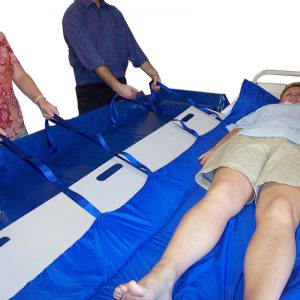WHAT IS THIS PRODUCT?
The Patient Turning Straps are designed to help turn someone who cannot roll onto their side when on their back on the floor. The Straps are particularly helpful for large and bariatric patients.
The Patient Turning Straps can be used on the floor or possibly on a bed. Just make sure that the bed and mattress are stable enough to allow for them to be used. It may be necessary to lower the bed and raise the bed rails, to stop the mattress from moving and to stop the person falling off the bed.
Patient Turning Straps Bag:
This Bag is a handy way to store the Patient Turning Straps when not in use. There is a pocket inside to keep the instruction sheet, and it is zip fastening. The Bag is made from a high-visibility material to make it easy to find if it is needed in an emergency. Order the Bag separately from the drop down box.
WHO IS THIS PRODUCT SUITABLE FOR?
Suitable for people who need assistance to roll onto their side.
BRIEF INSTRUCTIONS FOR USE
Place the Patient Turning Straps and Wedges on the floor next to the person. Slide one Grey Strap under the neck to under the opposite armpit. Then place the other Strap under the thighs, so the Strap goes up the opposite hip of the person.
Cross the Straps over the person’s chest and pull at an angle, so the Strap under the shoulder is pulled from the Rescuer standing or kneeling opposite the fallen person’s legs, and the Strap under the legs is pulled by the Rescuer standing by the person’s head.
The person’s arms and legs should be positioned to allow log rolling.
The red webbing loops are long enough to allow for two or three Rescuers on each of the two Straps. The ResQsheet Extension Straps can be attached to the red webbing loops, if extra length is required for more people to help with the turning.
When the person is on their side, a lifting device can be placed under them. This may be a Lifting Sling, Emergency Stretcher, or an air jack.
The model in these photographs is an able-bodied person who weighs over 150kg / 330lbs.
WHAT IS THIS PRODUCT MADE FROM?
Webbing, material.
ALTERNATIVE OR RELATED PRODUCTS
 |
ResQsheet Extension Straps |
 |
Emergency Stretcher |
















